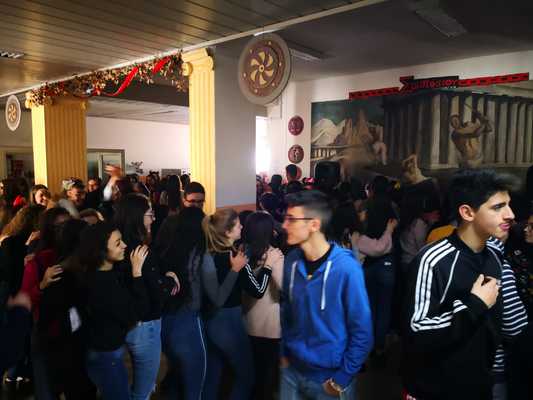
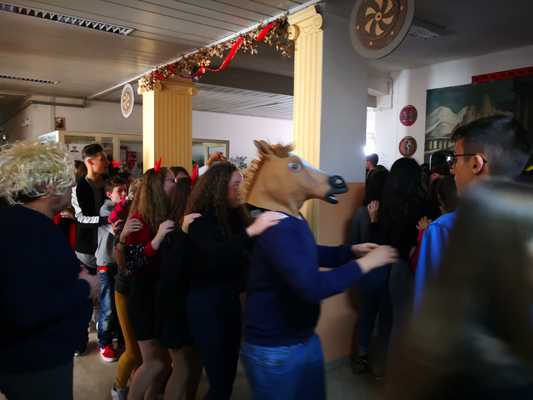
 Photos and videos related with the local traditions
Photos and videos related with the local traditions
EUROPEAN DAY OF WINE TOURISM IN THESSALONIKI CREECE (2 GENIKO LIKIO HORTIATI - P3 ACTIVITIES)
Every second Sunday in November wine tourism celebrates its day. On this Sunday, the main wine regions join the celebration with a wide and varied range of proposals for wine tourism lovers.
The Wine Tourism Day celebration is an initiative pioneered by the European Network of Wine Cities (RECEVIN), which has been held every year since 2009.
You can find more information about wine tourism at the following website:
http://www.wineroads.gr/en/
ARSAKLIOTIA FESTIVAL IN THESSALONIKI GREECE (2 GENIKO LIKIO HORTIATI - P3 ACTIVITIES)
During the Arsakliotika festival in Panorama (old name "Arsakli") Thessaloniki , every year in Autumn, there are events that include traditional music, folk dances and concerts with free entry to the public. The festival is a quality cultural event for the whole region.
CHRISTMAS CUSTOMS AND TRADITIONS IN THE JIU VALLEY (ROMANIAN SCHOOL) (P4 ACTIVITIES)
It's time to carol! A sign that some of us pretend not to hear. But who can actually say that they have finally buried the reflex of the miraculous expectation of the Christmas Night, the feeling of entering a sacred period? Christmas is the time of the year when each of us recalls and celebrates cheerfully, but at the same time, with the feeling of solemnity, the solemnity of several events that people perceive as one: the night when Jesus Christ was born.
"PITARAII "
Regarding the tradition of the "pitarai", some features can be observed in the ethnographic space of the Jiu Valley. In the villages over the Western Jiu River, in the past, only children aged 7 to 12 preserved the tradition of the “pitarai” as well as a few poor people. They used to gather at a household and from there, at around 7 or 8 a.m. they left, following the route that included all the small hamlets nearby shouting "Pitaraii, the wicked, the wicked!" There was only one group of people who played the role of the "pitarai".
If a second group was formed and came after the first group, they weren’t welcomed by the hosts, as it was believed that they had evil powers, "that they will steal their wealth". The “pitarai” were welcomed in each yard if the households were isolated, or in the common garden, if the households were grouped, where the hosts gathered to greet the guests. Before they left, each “pitarau” (member of this group) was forced to walk under an improvised "barrier", a bat held by two older children. The hosts who "hit the pitarai" stood in line, each having bags or baskets in which there were "treats”.
In the villages alongside the Eastern Jiu River, the custom of the “pitarai” is a collective carol for the whole community.
"At the entrance in the village, on Avramut's hill (in Slatinoara) I left with the pitaraii at 10 o’clock in the morning. We visited the households one by one. We were many and there was rarely a household where we were not welcomed. They were waiting for us with open gates and we received “tapau”. In front of us, kids aged 10-14 ran in the yard and started looking for a basket or a bucket in which the host laid “seeds”, that is candies or ginger bread. Amongst the most exciting “seeds” were the pieces of ginger bread. They were all kinds of shapes and beautifully coloured. The ginger bread, so beautifully coloured, was called "the chicken of the fair".
“Pitaraii" in the villages of the Eastern Jiu had flags. The number of flags varied between two and five, depending on the number of boys that formed the group of pitarai.
A 'pitarai' flag was made of a hazelnut pole of about two and a half or three meters long; at the top, over a length of one meter, it was adorned with red, green, blue, purple, woolen tassels and ribbons, traditional scarves of all colours and bells. These flags are worn in front of the pitarai.
This custom is not only found in the Jiu Valley, but also in Banat, Tara Hategului and in northern Oltenia.
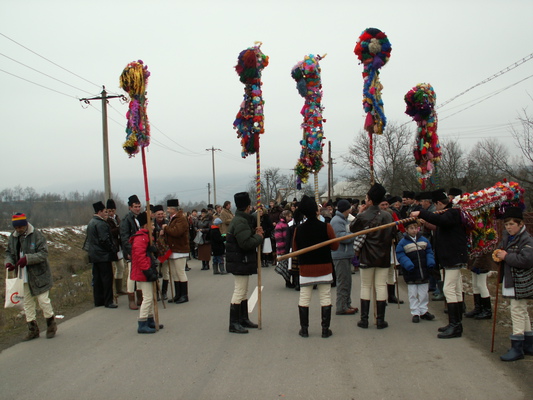
'PITARAII' IN JIETI, PETRILA, HUNEDOARA COUNTY (24 DECEMBER 2006) ( photo credit Mr DORIN RADUTI, history teacher)
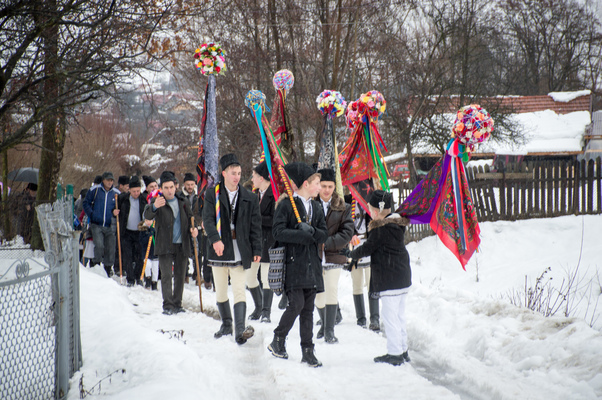
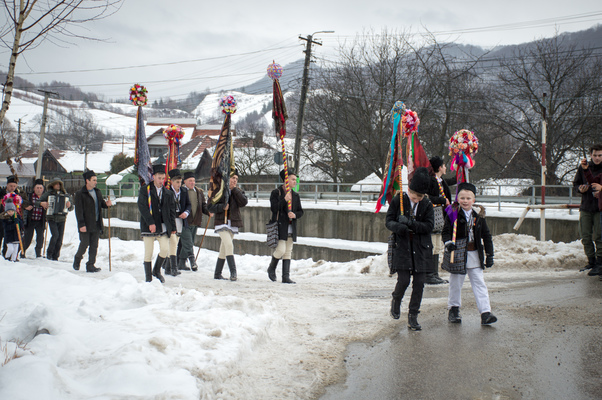 'PITARAII' IN JIETI, PETRILA, HUNEDOARA COUNTY (24 DECEMBER 2018) ( photo credit Mr SZEDLACSEK ROLLAND, IT engineer)
'PITARAII' IN JIETI, PETRILA, HUNEDOARA COUNTY (24 DECEMBER 2018) ( photo credit Mr SZEDLACSEK ROLLAND, IT engineer)
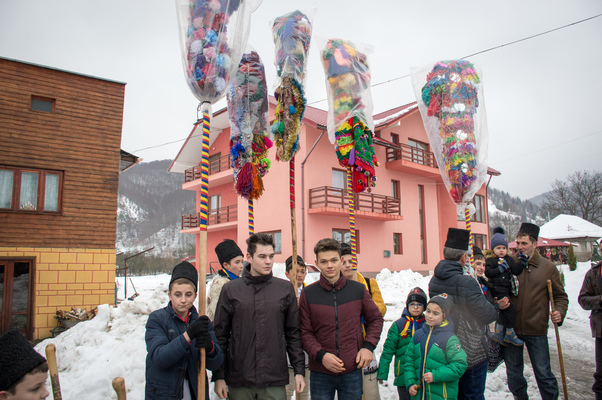
Two of the students from the target group, Andrei Voinic and Cristian Tiriplica who participated on 24 December 2018 at 'PITARAI' in Jieti, Petrila, Hunedoara County.( photo credit Mr SZEDLACSEK ROLLAND, IT engineer)
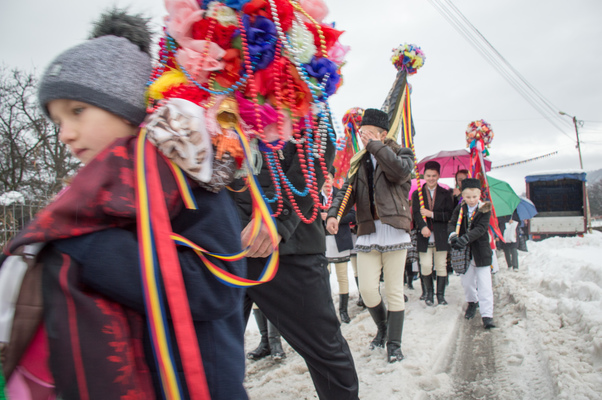
A 'pitarai' flag (details) ( photo credit Mr SZEDLACSEK ROLLAND, IT engineer)
The Wise Men
The custom of the Wise Men is relatively new for the Jiu Valley. The prepartion for the carolling period begins with the Christian fasting. During this time, the Wise Men prepared for the coming feast. They learned new or less known carols, prepared their costumes, shared their roles, practiced the movements and the lines for the play.
The leader of the play is Herod. Next is Valtezar, then Melhior and the one who plays Gaspar. Besides these four characters, we find secondary characters such as the angel, the soldier and the priest, 6-7 “blogi” and sometimes a taragot player.
The Wise Men’s costumes, representing different characters, including the Three Wise Men and King Herod, are in fact traditional folk ones with a “hat” that is decorated with something specific to each character: Irod (Herod)- rooster, Valtezar (Balthazar) - hen (they have distinctive signs on their hats ). On the back of the hats there are some ribbons called primes. Melfior (Melchior) and Gaspar (Caspar/Gaspar) don’t have any distinctive signs on the hats. On their shoulders they have differently coloured epaulettes in accordance with their rank: Herod - red, Valtezar - blue, Melfior- pink and Gaspar-yellow. They have two diagonal bands: a tricolour one and another one that matches the colour of the epaulettes on the chest. They wear leather gloves. In the past, like today, the swords they have are hand- crafted and their handles are decorated with so-called “epithets”, whose colour matches that of the epaulettes and the diagonal band. The angel’s costume resembles that of the King, but it doesn’t have any distinctive signs. The sword is replaced with a beautifully carved horn bat. Priest Seraphim, a character that is dressed like a priest, holds in his hands a metal cross and a “Bible”. His costume, gestures and vulgar language are a parody of real priests that pretty much acted in the same manner.
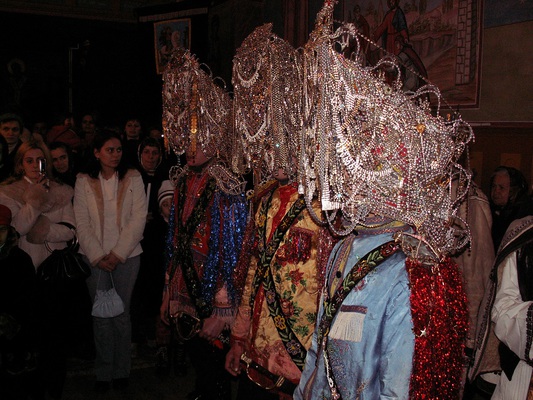
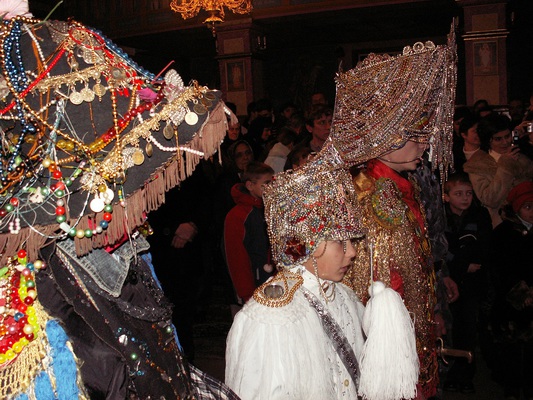 The Wise Men ( 25 December 2006) ( photo credits Mr DORIN RADUTI, history teacher)
The Wise Men ( 25 December 2006) ( photo credits Mr DORIN RADUTI, history teacher)
The carolling begins with the most important people in the village, like the priest, mayor or doctor, continues with the most affluent people and after them, with the rest of the villagers. They start with a carol whose melodic line is more accessible to follow and then, they sing one or two more difficult carols. Next the play itself follows, which is called “The Wise Men”. It is a popular lyrical drama based on the dialogue between Herod and the Magi from the Gospel and other religious sources that are apocryphal texts. This religious drama presents the mystery that shrouds the birth of Jesus, from beginning to end.
THE “BLOGI” are dressed in sheep skin coats (sheepskin) which they wear inside out from which tassels of different colours are sewn; they have around their chest and waist a hemp rope that connects the bells of different sizes (which, when walking, make an unbearable noise); on the head, they wear a lambfur hat of different colours and the face is covered with a richly adorned inside out lambfur mask. It has holes for the eyes, nose and mouth. Around the mouth there are sewn beans that symbolize teeth. In their hands they have shepherd’s sticks. The custom is too old and impossible to uproot. The Church was pleased to give it a new interpretation by regarding the ‘blogi’ in their ugly costume that embodies the forces of darkness, the Satanic forces in constraint with the beautiful garments of the Wise Men who represent the forces of the divine light that is now born. If two groups of Wise Men meet on the road, there is a "confrontation" between the “blogi”. A “blog” from each group is supposed to “fight in spikes” to show the superiority of the group that they were part of. The confrontation usually ends undefined because the defeat of one “blog” automatically results in the dissolution of the group of Wise Men he belonged to.
The text was created under the coordination of Mr Dorin Raduti, history teacher, and then, it was translated by the students from the target group: Deliana Dinu, Diana Bozea, Denisa Petraru, Eduard Kontos and Razvan Parvulescu)
ARTISTIC JUNE FESTIVAL IN PILEA-HORTIATIS GREECE (GENIKO LIKIO HORTIATI - P5.2 ACTIVITIES)
In June 2019 the pupils of the erasmus+ project of GENIKO LIKIO HORTIATI attended the “Artistic June Festival” of the municipality of Pilea-Hortiatis, in particular a theatrical performance about the literacy work of the famous Greek writer Nikos Kazantzakis, folklore dances and the drama performance “The Women of Troy” by the ancient writer Euripides.
- Attending a theatrical performance about the literacy work of the famous Greek writer Nikos Kazantzakis
On June 5, 2019, the pupils of the Erasmus+ project of our school and Ms. Maria Mangana attended the theatrical performance "The Eagle and the Beast" a tribute to the Cretan writer Nikos Kazantzakis (who have already studied during the P5.2 Activity) and to the Cretan singer-musician Nikos Xylouris. The theatrical performance was co-organized with the "MIMISSIS PRACTICE" Theatrical Group of the West Thessaloniki Secondary Education Directorate in the framework of the “Artistic June Festival” of the municipality of Pilea-Hortiatis. The performance was a theatrical “tour” through the thoughts and the indomitable mind of Nikos Kazantzakis… through its deep foundations, through what he fought until the end of his life, a tour of music and dance with songs remembered and sung by Nikos Xylouris.
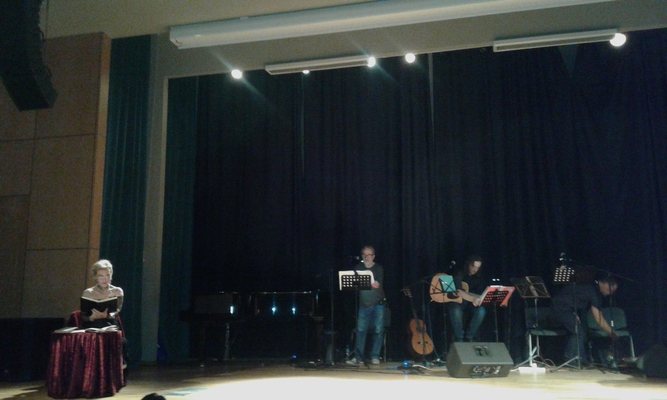
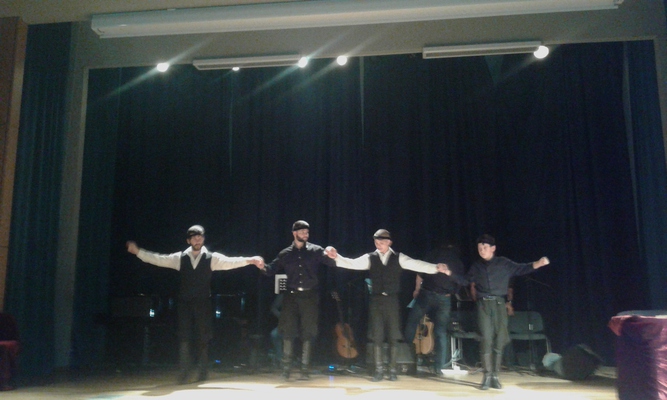
- Attending the performance "Stories of Pilea”
On June 14, 2019, the pupils of the Erasmus+ project of our school and Ms. Maria Mangana attended the performance "Stories of Pilea” in the framework of the “Artistic June Festival” of the municipality of Pilea-Hortiatis. The performance was a combination of traditional dances from all over Northern Greece and short theatrical plays (comedies) about the daily life of the past.

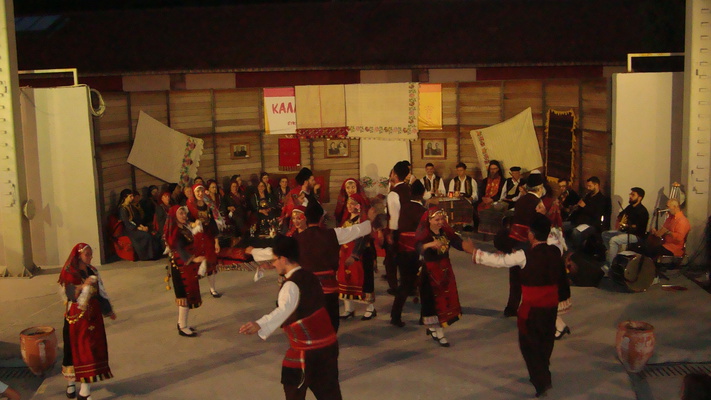
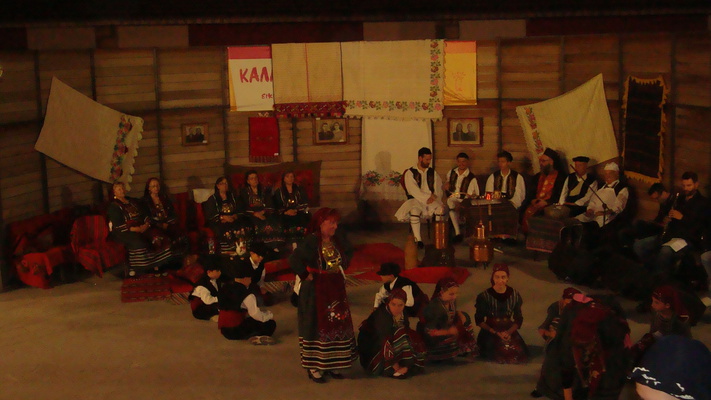
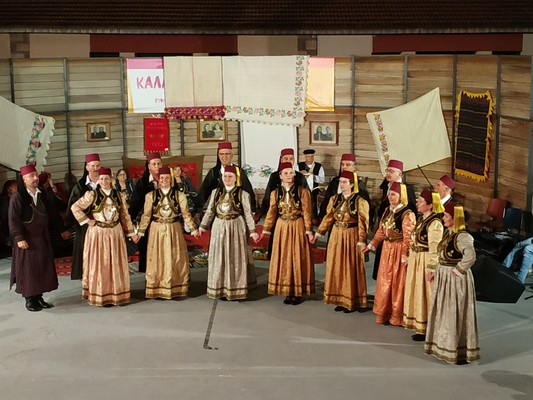
- Attending the drama performance "The Women of Troy” by the ancient writer Euripides
On June 22, 2019, the pupils of the Erasmus+ project of our school and Ms. Maria Mangana attended the drama performance "The Women of Troy” by the ancient writer Euripides. The performance was held by “The Teenage Theater Group G” in the framework of the “Artistic June Festival” of the municipality of Pilea-Hortiatis
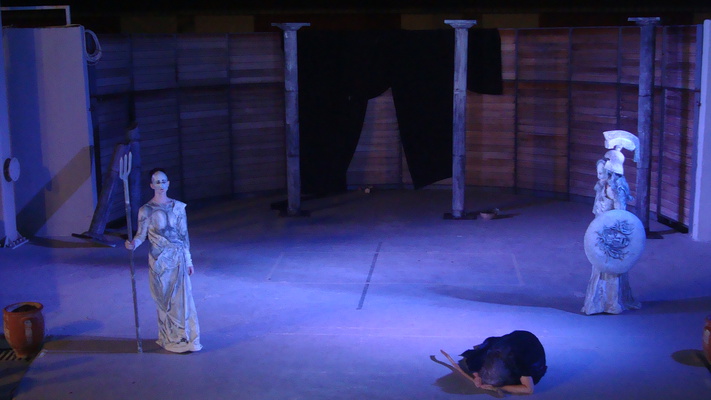
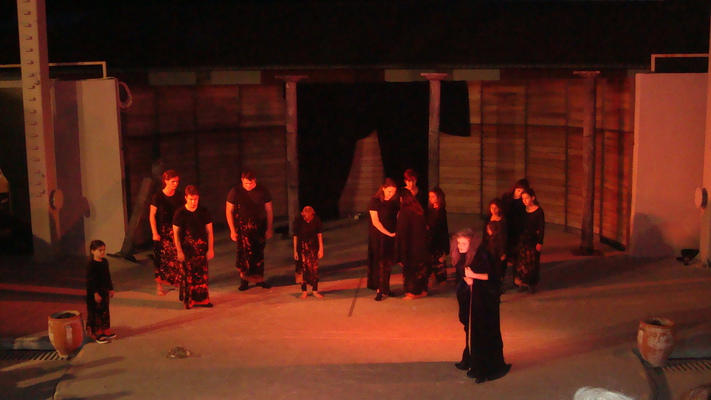
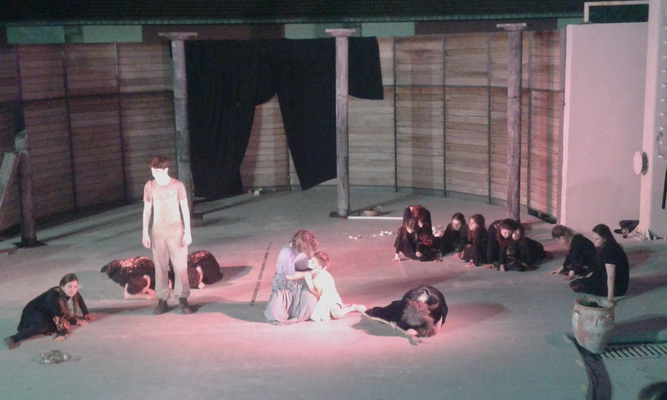
"The Women of Troy (The Trojan Women)” is the third tragedy of a trilogy written by Euripides in 415 BC during the Peloponnesian War. It refers to the Trojan war. For this work he won the second prize, losing to the tragic poet Xenocles.
Euripides' drama describes the fate of the women of Troy after their city was plundered, their husbands killed, and their families would become slaves. The case takes place in the Achaean camp on the coast of looted Troy. The war captive women of Troy and their queen, Ekavi, mourn their plagues. Those who survived will be given as gift to the Achaeans while Ekavi's grandson, the young Astyanaktas, is aborted down from the walls, a victim of the cruelty of the conquerors. The flames destroy Troy and the women, desperate, are taken to the ships that will carry them across the Aegean, as slaves to the winners' homes.
In 415 BC, when "The Women of Troy” was written, the Athenians were entangled in the Peloponnesian war and were preparing for the Sicily expedition, while the previous year, in 416 BC they had committed the massacre of the inhabitants of Milos island, who were demanding neutrality between Athens and Sparta.
Euripides's drama is a relentless "blame" for the atrocities of war and a compelling demand for solidarity and humanity.
In 1965 Jean Paul Sartre wrote a version of Euripides's drama, “Les Troyennes”, in which we find references to the European imperialism in Asia, while in 1971 the famous Greek director Michalis Kakoyiannis transferred the drama to a cinema play, starring Katharine Hepbur, Vanessa Redgrave (Andromachi), Brian Blessed (Talthibius), Geneviève Bujold (Cassandra), Irene Pappa (Helen) and Patrick Magee (Menelaos). The music of the film was signed by the famous Greek music writer M. Theodorakis.
“The Women of Troy” of Euripides, a unique peace symbol, live and relive in every war. Thousands of years later the women of Troy revive, complaining about the winners' arbitrariness over the losers. Euripides by his drama “The Women of Troy”, through Neptune’s words, warns: "Everyone who traverses cities, ruins temples, sanctuaries and graves of the dead is a fool. At the end, he will be the loser too".
Seventy five (75) years after the Holocaust by the Nazis in Hortiatis (September 1944), the women of Hortiatis, as other “Women of Troy”, remind us that the woes of war stigmatize people's psyche. Dozens of women experienced the violence of the war and incarnated, against their will, an Ekavi, a Cassandra or an Andromachi.
That is why Euripides's drama remains timely, reminding us of the need for peace and reconciliation of all people, especially in Europe, which is our common home.
References
https://www.sansimera.gr/articles/945
https://el.wikipedia.org/wiki/%CE%A4%CF%81%CF%89%CE%AC%CE%B4%CE%B5%CF%82
The Teenage Theater Group G